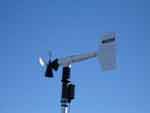More than two years after road access and electrical power to the Mauna Loa Observatory was cut off by lava flows, NOAA staff continue to make critical measurements of the atmosphere and other environmental variables at the remote site.
In 2023, observatory staff installed solar panels at the site and resumed some measurements, including the independent carbon dioxide monitoring programs run by the Global Monitoring Laboratory and Scripps Institution of Oceanography, as well as other atmospheric measurements.
Construction of a temporary road to access the observatory site is anticipated to begin in summer 2025.
Media can contact: Theo Stein (303) 819-7409 (theo.stein@noaa.gov)
Organization(s):
 Carlsbad Environmental Monitoring & Research Center (CEMRC)
Carlsbad Environmental Monitoring & Research Center (CEMRC)
 New Mexico State University (NMSU)
New Mexico State University (NMSU)
 National Science Foundation (NSF)
National Science Foundation (NSF)
What does this program measure?
We collect bulk aerosol samples for chemical (dust) and radiochemical analyses.
How does this program work?
Filter samples of aerosol particles are collected continuously with single simple high-volume sampler (Model 500EL Aerosol Sampler). Samples are shipped to NMSU where they are analyzed for trace elements and radionuclides (one quartz fiber filter are used for both types of analyses).
The objective is to obtain sufficient material for the radiochemical analyses (several grams preferably). Initial plans are to collect the samples until the flow rate drops to 90% of the starting flow.
Daily observations of the sampler flow reading are needed.
Why is this research important?
In order to determine whether Asian dust is contaminated with radionuclides from historical weapons tests.
Are there any trends in the data?
This project began in 2005. Radiochemical analyses are time consuming, probably 1.5 to 2 months after sample receipt. Trace elements results will be faster,~1 month. Data will be posted on the CEMRC / NMSU web site http://www.cemrc.org/
How does this program fit into the big picture?
What is it's role in global climate change?
The study involves the collection of bulk aerosol particle samples followed by radiochemical and chemical analyses. For the part of the project involving CMDL, high-volume aerosol samples are collected at Mauna Loa. The samples are collected by station personnel and shipped to the CEMRC / NMSU for analysis. There the activities of two radionuclides (239,240Pu and 241Am) are determined by alpha spectrometry following purification involving column chromatography and multiple co-precipitation and precipitation steps. These nuclides were globally distributed as a result of atmospheric nuclear weapons tests and have been subsequently transported throughout the environment. The concentrations of aluminum, an indicator of mineral dust, and other trace elements also will be determined by inductively-coupled plasma mass spectrometry following acid digestion.
The results of the radiochemical and chemical analyses will be combined to evaluate quantitatively the relationships between the radionuclide activities and dust concentrations, that is, to determine whether Asian dust is contaminated with radionuclides in the same way that dust from North America has recently been shown to be contaminated (Arimoto et al, 2002). The data from the CMDL site will be combined with similar data from Jeju ( Korea) and Barbados, to evaluate the relationships between atmospheric dust concentrations and the activities of 239,240Pu and 241Am in samples of the world’s main dust sources. While the main focus of the study is on the biogeochemical cycling of dust and radionuclides, the results of the study may well have important implications for geology, public health, and homeland security.
Comments and References
Lead Investigator(s):
Richard Arimoto
505-234-5503
MLO Contact(s):
Trevor Kaplan
808-933-6965
Web Site(s)
Date Started
2005

